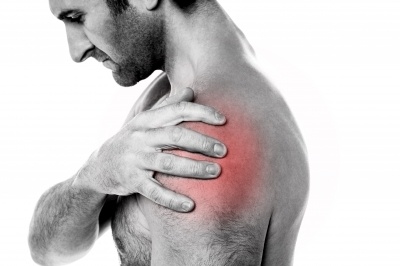What’s Causing Your Shoulder and Neck Pain?

Many people experience shoulder and neck pain while moving their upper extremities or lifting heavy weight. In order to resolve this kind of pain, it helps to first understand the potential causes and the anatomy of this area of the body.
The shoulder joint is formed by the ball shaped head of the humerus (long bone of the upper arm) articulating with the socket of the scapula (shoulder blade) and the clavicle (collar bone). The socket where it articulates is called the glenoid cavity. There are many muscles and tendons that support the joint and form a rotator cuff around the joint preventing dislocation.
Causes
Shoulder and neck pain can be caused by rheumatoid arthritis, osteoarthritis, inflammation of the tendons, fracture, radiating pain from distant places, dislocation, frozen shoulder or bursitis.
- Arthritis: Typically experienced as pain and limited range of movement while moving the hand above the shoulder – like while combing hair, arthritis is caused by inflammation of the synovial fluid and the synovial membrane.
- Osteoarthritis: Related to wear and tear of the joints, osteoarthritis causes the formation of bony spurs (also called as outgrowths) on the smooth surfaces of the bones. The articulating surfaces become rough and there is decreased joint space, which causes pain with movement.
- Tendonitis and Bursitis: The tendon is a strong cord-like structure that connects the muscle to the bone. Whenever there is a jerky movement, there is a pull produced in the joint that eventually leads to wear and tear of the tendon. Tendonitis can be acute or chronic. In acute tendonitis there is pain suddenly starting due to forceful and erroneous movements, whilechronic tendonitis is due to repeated movements of the same joint.
- Bursitis: A bursa is a small fluid-filled sac that acts as a cushion between the articulating bones to reduce friction during the gliding movements of the body. Pain occurs when the bursa in the joint become inflamed.
- Frozen Shoulder: A sudden pain and spasm of the shoulder joints and muscles supporting the joint, frozen shoulder restricts the abduction movements (when the upper arm moves away the body), especially above the level of the shoulder. Exercise can help reduce the muscle stiffness and pain.
- Fracture: A crack or break in the bones can be caused by injury, trauma or an accident. This is an extremely painful condition and typically will take a long time to heal. A cast will be necessary to keep the joint immobile until it heals.
- Radiating Pains: Whenever there is chest pain or myocardial infarction (heart attack) it leads to squeezing pain on to the left side of the chest and in the heart muscles as well. This chest pain typically radiates from the heart to the left shoulder blade and the shoulder joint. If the patient has past history of heart problems as well as dyspnea and an unstable electrocardiogram then one should rule out angina pain immediately.
- Dislocation or Subluxation of the Joint: The head of the humerus may come lower down from the socket in case of loosened tendons and ligaments and increased strenuous activities. The dislocation is medically termed as subluxation. It may be partial or complete. In case there is dislocation once there may be repeated dislocation on account of worn and loose ligaments. The limb will be stiff and the head of the humerus dislocates downward, causing pain while moving the hand upwards.
Diagnosis of shoulder and neck pain is typically conducted by taking a detailed history and clinical examination. This may include:
- X-rays will give information about the contour of the bones and can detect minute hairline fractures. This is the most basic test done by the orthopedic surgeon.
- CT scan will show detailed structure about the bones and surrounding soft tissues of the shoulder joint.
- MRI scan will show injuries and abnormalities of the soft tissues like tendons and ligaments.
- ECG will help interpret cardiac functioning, rate and rhythm.
- Arthrogram is a specialized X-ray wherein a dye is injected into the joint. This chemical dye produces a contrast effect when an X-ray is taken for the joint, enabling a better view of the bones, ligaments and the tendons.
Treatment for Shoulder and Neck Pain
Treatment consists of lifestyle modification, conservative modalities of treatment and medications or surgery. In case of lifestyle modification, one has to give intermittent rest to the joint that is painful, avoiding exertion and excessive use. Conservative treatment allows the patient to increase joint flexibility with physiotherapy exercises. Medications that can help relieve pain include:
- Trigger Point Dry Needling
- Analgesics (painkillers)
- Supplements like calcium and ginseng, which allow the bones to become strong and stable.
- Antibiotics are helpful in case of tendonitis and bursitis as they reduce the inflammation levels.
- Non Steroidal Anti-Inflammatory Drugs are given in case of rheumatic arthritis of the shoulder joint for longterm relief.
Surgical intervention is needed in case of fracture or break in the bones. Cast or crepe bandage is useful in cases where rest and support to the ligaments is needed in cases like dislocation of shoulder.
Shoulder and neck pain can be debilitating. For help determining the cause of your pain and identifying an appropriate treatment plan, contact Warner Orthopedics and Wellness at 225-754-8888 or visit HERE.
Image courtesy of stockimages / FreeDigitalPhotos.net




